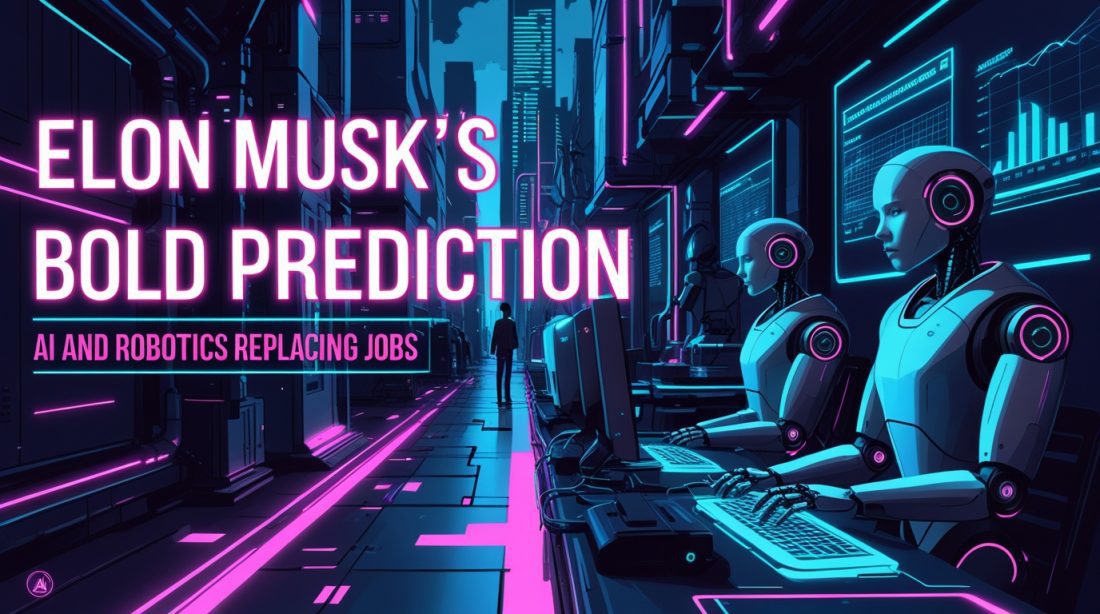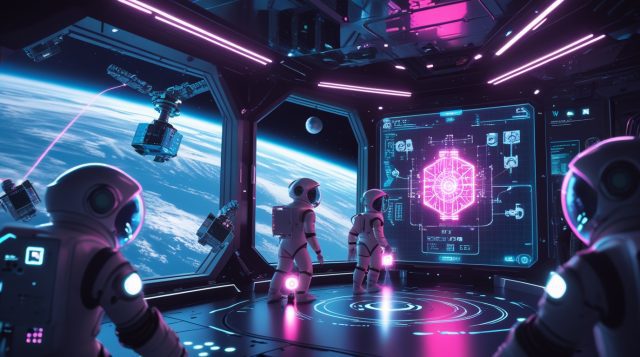In a world run by AI, the most valuable human skill may be knowing what to ask for.
Elon Musk has done it again. At a recent international investment forum, the Tesla and SpaceX CEO made a bold prediction that has since sent ripples through the global economic landscape: work will become optional within 10 to 20 years.
For industrial AI analysts and manufacturing leaders, this isn’t just futuristic speculation—it’s a strategic foresight that demands immediate attention. Musk’s vision suggests a complete transformation of production lines, supply chains, and labor economics through AI and robotics replacing jobs at scale. This analysis examines not just what Musk predicted, but more importantly, why this transition would fundamentally reshape industrial operations and what smart manufacturers should be doing today to prepare for tomorrow’s automated reality.
Why Musk Believes Traditional Work Will Disappear
Elon Musk’s prediction stems from a straightforward technological premise: artificial intelligence and robotics are advancing at a pace that will eventually make human labor economically unnecessary for most production and services.
The “Optional Work” Thesis
Musk envisions a future where economic production is largely handled by “millions of robots in the workforce,” creating such abundance that the traditional necessity of employment disappears. He compares future work to “growing vegetables in your backyard”—an activity one chooses for personal satisfaction rather than economic necessity.
This isn’t merely an extension of current automation trends. Musk suggests a complete paradigm shift where Tesla’s Optimus robots and similar systems become so pervasive that up to 80% of Tesla’s long-term value could eventually come from robotics rather than automotive manufacturing.
AI and Robotics Replacing Jobs: Musk’s Vision of Optional Work and Industrial Transformation.
For industrial sectors, this vision implies a total reimagining of production floors. Instead of human workers supervising automated systems, AI-driven robots would manage entire production cycles with minimal human intervention. The implications for manufacturing efficiency, facility design, and global supply chains are profound—potentially eliminating the traditional constraints of shifts, breaks, and human error from production equations.
What Technology Will Enable This Transformation
The realization of Musk’s prediction hinges on critical advancements in both hardware and software systems. From an industrial perspective, the evolution must occur across multiple technological fronts simultaneously.
The Robotics Scaling Challenge
While Musk is bullish on humanoid robots like Optimus, industrial applications face practical hurdles. Physical robotics “are stubbornly expensive, making them harder to scale,” according to Ioana Marinescu, an economist and associate professor at the University of Pennsylvania. This is particularly relevant for industrial settings where specialized equipment often proves more efficient than general-purpose humanoid robots for specific manufacturing tasks.
Current industrial robotics operate in constrained environments with limited adaptability. Achieving the flexibility needed to replace human workers across diverse manufacturing roles requires significant advances in dexterity, contextual understanding, and problem-solving capabilities.
AI’s Asymmetric Progress
The software component appears to be advancing more rapidly than physical robotics. Large language models and AI systems can now “write production-grade code, design hardware, plan logistics, generate legal drafts, and analyze markets”. In industrial contexts, this translates to AI that can optimize production schedules, predict maintenance needs, redesign components for manufacturability, and troubleshoot quality issues—functions traditionally requiring human expertise.
However, Yale Budget Lab research from October 2024 found that since ChatGPT’s November 2022 release, the “broader labor market has not experienced a discernible disruption” because of AI automation. This suggests that workplace integration may lag behind technological capability, especially in regulated industrial environments with significant legacy systems.
How the Economy Would Function Without Work
The most radical aspect of Musk’s vision isn’t the technological transformation but the proposed economic restructuring that would accompany it.
The Transition to Universal High Income
Musk has suggested “universal high income” would sustain a world without necessary work. This concept extends beyond today’s discussions of universal basic income to suggest a society where abundance is so widespread that income distribution becomes largely decoupled from employment.
From an industrial perspective, this raises fundamental questions about consumption patterns, demand forecasting, and market dynamics. If traditional employment disappears, what mechanisms would drive purchasing decisions? How would capital investment decisions be made? Musk offers few details on how this system would function practically.
Money’s Diminishing Relevance
Looking further ahead, Musk speculates that “money will stop being relevant at some point in the future“. He suggests that in a world of extreme abundance, currency becomes unnecessary, though physical constraints on resources like “power, electricity and mass” would remain.
For manufacturers, this suggests a long-term trajectory where traditional pricing models, cost accounting, and profit motivations might gradually evolve toward different operational paradigms. While this sounds like science fiction today, it aligns with Musk’s acknowledgment that he’s drawing inspiration from Iain M. Banks’ Culture series of science fiction novels, which imagine post-scarcity civilizations without traditional jobs or money.
Why Human Purpose Becomes Central in a Post-Work Society
Perhaps the most challenging aspect of Musk’s vision isn’t the technological or economic transition, but the human dimension. If work disappears, what provides meaning and structure to human life?
The Psychological Shift
Anton Korinek, professor and faculty director of the Economics of Transformative AI Initiative at the University of Virginia, notes that “if the economic value of labor declines so that labor is just not very useful anymore, we’ll have to rethink how our society is structured”. He references research showing that humans derive satisfaction from meaningful relationships, many of which currently form through workplace interactions.
Musk himself acknowledged this existential dimension, asking: “If the computer and robots can do everything better than you, does your life have meaning?” His tentative answer is that “we may give AI meaning”—suggesting a role reversal where humans provide purpose rather than productivity.
Industrial Organizational Implications
For manufacturing leaders, this human dimension cannot be overlooked. Even as automation increases, companies must navigate transitional decades where human workers remain essential while gradually being displaced from traditional roles.
Kaz Hassan, principal of community and insights at AI-powered EX platform Unily, argues that organizations must “stop conflating automation of tasks with elimination of human contribution“. The most successful operations will be those that create “superworkers” who are “confident in their uniquely human value and skilled at using AI agents to amplify their judgment, creativity and strategic impact”.
Why Industrial Implementation Faces Significant Hurdles
While Musk’s vision is compelling, industrial applications face distinct challenges that may delay or reshape the transition he describes.
The Timeline Problem
Musk’s 10-20 year forecast appears optimistic given current industrial automation capabilities. Marinescu notes that despite rapid AI progress, physical machines “are not only more expensive, but highly specialized, contributing to the slowdown in their workplace implementation”.
Industrial environments present particular challenges—dirty, unpredictable settings with variable lighting, temperatures, and unexpected obstacles. These conditions dramatically complicate the deployment of general-purpose automation compared to controlled laboratory or office environments.
The Economic Inclusion Question
Perhaps the most significant uncertainty is whether AI-driven abundance would be widely shared. Samuel Solomon, an assistant professor of labor economics at Temple University, notes that “AI has already created so much wealth and will continue to. But I think one key question is: Is this going to be inclusive?”
Current evidence suggests concerning trends. A report by Apollo Global Management found that gains from the AI boom have disproportionately favored top investors—especially those in the “Magnificent Seven” tech stocks—while the broader market has seen earnings projections decline. For manufacturers, this distribution question translates to concerns about whether automation benefits will be captured primarily by equipment providers and large corporations or shared across the industrial ecosystem.
Preparing for an Automated Industrial Future
Elon Musk’s vision of optional work represents both a strategic destination and a complex transition challenge for industrial leaders. The companies that thrive in coming years won’t be those that simply automate everything possible, but those that thoughtfully integrate AI and robotics to enhance both productivity and human capabilities.
The most successful manufacturing operations will likely be hybrid environments where AI handles optimization, prediction, and repetitive tasks while humans focus on exception handling, creativity, and strategic direction. As Musk himself noted, in this future “the question will really be one of meaning”—for both individuals and organizations.
For industrial professionals, the message is clear: the technical capabilities may eventually make optional work possible, but the human, economic, and implementation challenges will determine whether this future becomes practically achievable.
Fast Facts
Elon Musk predicts AI and robotics replacing jobs will make traditional work optional within 10–20 years, with universal high income supporting populations and money potentially becoming irrelevant. While the vision is compelling, significant technological hurdles in robotics scaling and unanswered economic questions about distribution make the timeline optimistic. Industrial leaders should focus on gradual AI integration while developing human capabilities that complement rather than compete with automation.
Stay ahead of the curve on industrial AI trends. Subscribe to our newsletter for monthly analysis on how automation is transforming manufacturing and what it means for your operations.
Further Reading & Related Insights
- Robotics in Nigerian Factories: Downtime Reduction → Connects Musk’s vision to real-world robotics adoption in African manufacturing, showing how automation reduces reliance on human labor.
- Three Lives of a Robot: Industrial AI → Explores the lifecycle of industrial AI robots, resonating with Musk’s prediction of robots dominating future work.
- AI-Powered Industrial Automation: Rivian Mind Robotics → Demonstrates how AI-driven automation is already reshaping production lines, echoing Musk’s forecast of optional work.
- Why Domain Randomization in Industrial Robotics Is the Secret Weapon Behind Smarter, More Resilient Automation → Highlights resilience challenges in robotics scaling, directly tied to Musk’s concerns about technological hurdles.
- How Industrial AI Is Powering $44 Billion in Revenue by 2025 and the Rise of Crypto AI Agents → Shows the economic impact of industrial AI, linking automation to wealth creation and distribution questions Musk raised.



